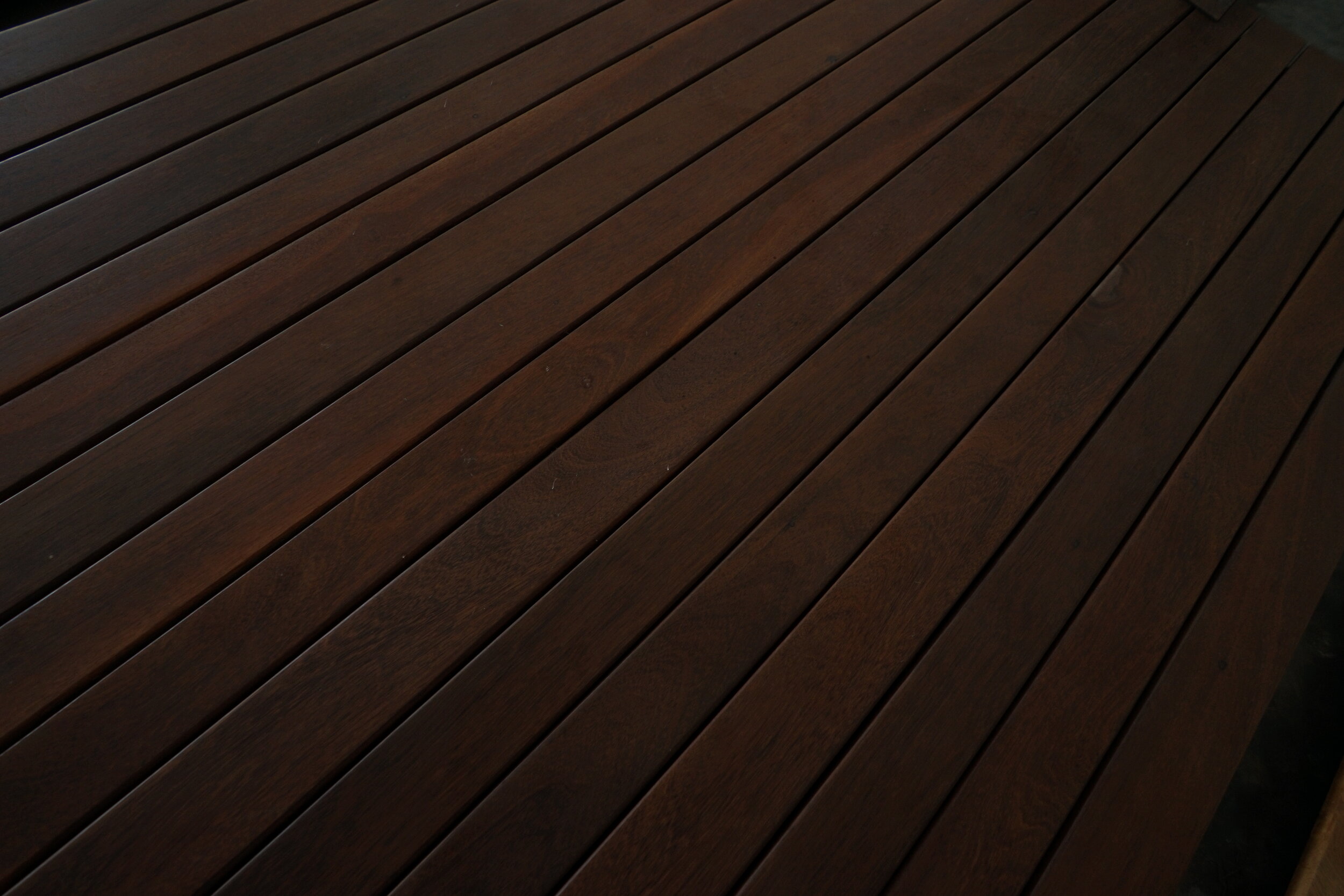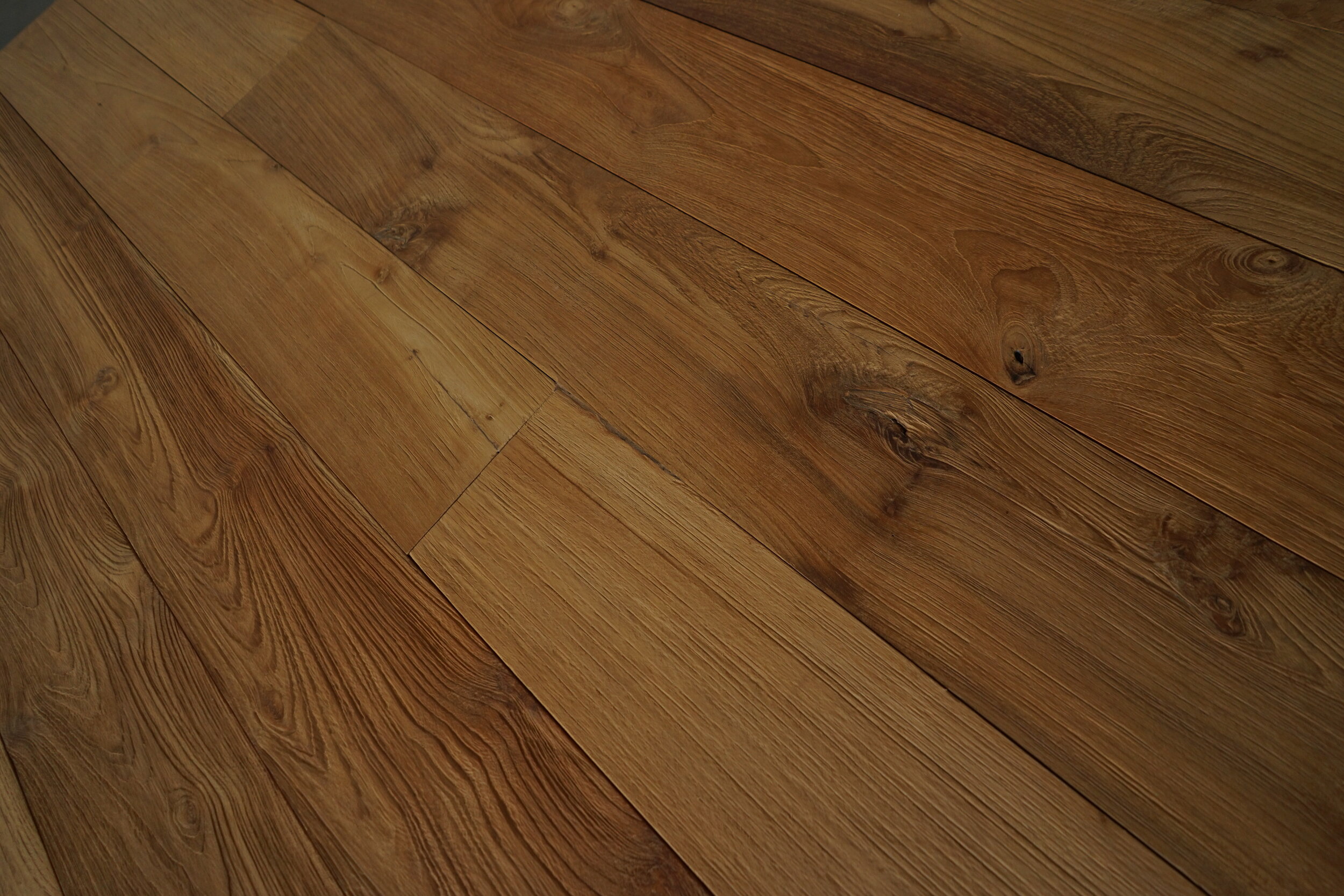Our reclaim hardwood
Kaltimber provide a certified 100% recycled Ulin ironwood supply to every single wood lover.
We are carefully reclaiming from disused structures and work in close relation with the Forest Ministry to ensure a fully legal wood supply ready for local sale as well as export.
With extremely competitive price Kaltimber is making sure no wood lover is left behind, from small private project to hotels and nationwide distributors.
Ulin decking smooth natural finish
Our specialty, Ulin Kalimantan!
We are specialized in reclaiming ironwood from Kalimantan. All our wood comes from legal and verified sources, and we transform it, for the most part, into decking and flooring.
More information can be found in the categories Decking and/or Flooring.
More about Ulin
Ulin is a remarkable wood. It's extremely slow growth rate at less than 0.5mm a year results in a highly dense wood ideal for exterior applications. Ulin is a rare tree native to Indonesia. It is threatened by habitat loss.
The government of Indonesia and the state government of Sarawak have formally banned the export of this species. Illegal smuggling continues to be a major problem. It grows in lowland primary and secondary forest up to 625m altitude. It is commonly found along rivers and adjacent hills. It requires an average annual rainfall of 2500–4000 mm.
This very important tree is one of the most durable and heaviest timbers in the world. Ulin trees can grow to attain over 1,000 years of age. Common commercially exploitable trees attain a height of 30 or more metres (100 ft) with trunk diameters of exploitable trees up to 92 cm (36 inches).
Trade & local names: Borneo ironwood, billion, belian, biliran, Kalimantan ironwood
Found in: Indonesia, East Malaysia, Philippines
Qualities: Growth ring boundaries indistinct or absent. Heartwood basically brown to yellow, without streaks. Sapwood colour distinct from heartwood colour. Odor has faint lemon scent. Heartwood with yellowish to greenish (olive) hues when fresh, dark brown to almost black upon exposure.
Density: 0.85–1.1 g/cm³
Durability: Class 1
Uses: Heavy engineering, ulin ironwood decking. Due to the excellent resistance to bacterial, fungal, insect and marine borer attack the wood is highly prized for many outdoor uses. Internationally, it is renowned for heavy construction such as a buffer between transportation trailers and heavy steel fabrications (such as boilers, pressure vessels, reactors and many others). It is also frequently found in dry docks as a timber to separate the hull of ships from the steel supporting stands. Can be used on exposed flooring.
Status: Listed as vulnerable by the IUCN (World Conservation Union). The species is threatened by over-exploitation, predominantly by illegal loggers. Current demand for the timber is fueled for its esteem among Chinese as a coffin wood (as it is resistant to insect and rot). Included in list of vanishing timber species of the Philippines and considered almost extinct in Sabah. In Java and Sumatra it exists solely in National Parks. Currently the situation is assessed as a serious depletion of stands.
Teak flooring wirebrushed
Partner product, Teak.
One of our trusted partner specialize in reclaiming Teak from Java. All their wood comes from legal and verified sources, and is transformed , for the most part, into decking, flooring and wall panel.
For more information feel free to contact us.
More about teak
Teak is a large, deciduous tree that is dominant in mixed hardwood forests. It has small, fragrant white flowers and papery leaves that are often hairy on the lower surface. Teak timber is particularly valued for its durability and water resistance. The word teak comes from Tamil “tekku” and Malayalam word thekku. From there it went to Portuguese “teca.” Tectona grandis is found in a variety of habitats and climatic conditions from arid areas with only 500 mm of rain per year to very moist forests with up to 5,000 mm of rain per year.
Teak has been used as a boat building material for over 2000 years. In addition to relatively high strength, teak is also highly resistant to rot, fungi and mildew. In addition, teak has a relatively low shrinkage ratio, which makes it excellent for applications where it undergoes periodic changes in moisture. Teak has the unusual properties of being both an excellent structural timber for framing, planking, etc., while at the same time being easily worked.
Trade & local names: Jati, tiki, Burmese Teak
Found in: Indonesia, India, Pakistan, Sri Lanka, Burma, Thailand, Laos, Vietnam, Cambodia, and tropical Africa
Qualities: Heartwood is dark yellow-golden, sapwood is narrow, a pale yellow-brown. Growth ring boundaries and odour distinct. Teak's natural oils make it useful in exposed locations, and make the timber termite and pest resistant. Teak is durable even when not treated with oil or varnish. Teak's high oil content, high tensile strength and tight grain makes it particularly suitable for outdoor use. Over time teak can mature to a silvery-grey finish, especially when exposed to sunlight.
Uses: Boat building, decking, all types of joinery, framing, flooring. One option is to use no finish at all, in which case the wood will naturally weather to a pleasing silver-grey. The wood may also be oiled with a finishing agent such as linseed or tung oil. This results in a pleasant, somewhat bland finish. Finally, teak may also be varnished for a deep, lustrous glow.
Density: 0.44–0.63–0.82 g/cm³
Durability: Class 2
Status: Old growth teak forests are difficult to find. Burma is the only country that still exports teak from natural forests. Indonesia has established teak plantations originally introduced by the Dutch and is the world’s second biggest teak producer.


